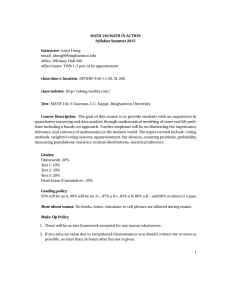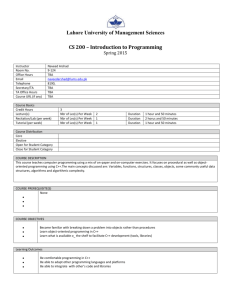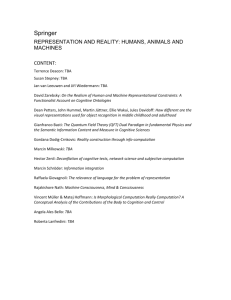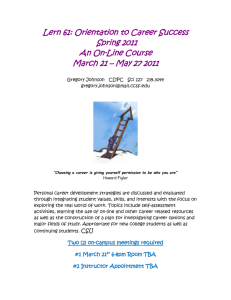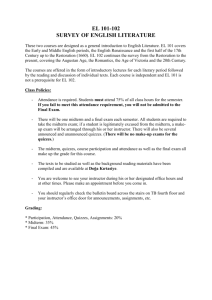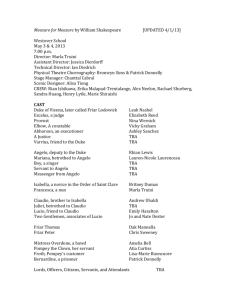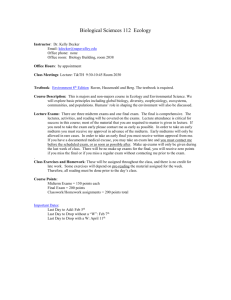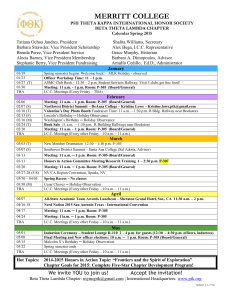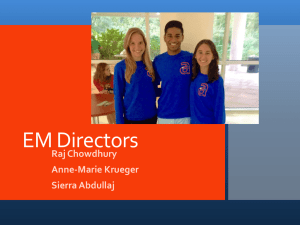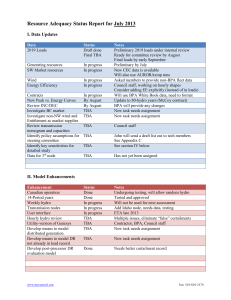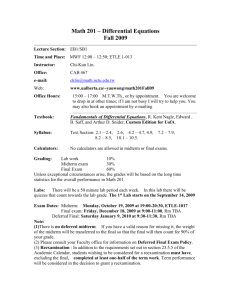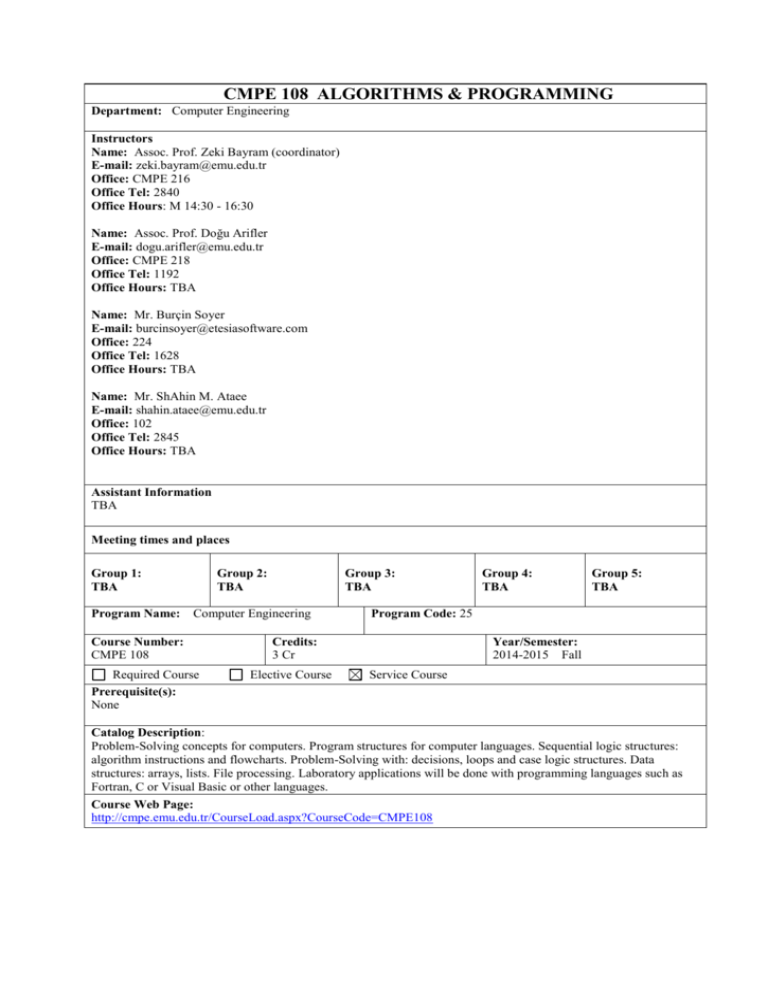
CMPE 108 ALGORITHMS & PROGRAMMING
Department: Computer Engineering
Instructors
Name: Assoc. Prof. Zeki Bayram (coordinator)
E-mail: zeki.bayram@emu.edu.tr
Office: CMPE 216
Office Tel: 2840
Office Hours: M 14:30 - 16:30
Name: Assoc. Prof. Doğu Arifler
E-mail: dogu.arifler@emu.edu.tr
Office: CMPE 218
Office Tel: 1192
Office Hours: TBA
Name: Mr. Burçin Soyer
E-mail: burcinsoyer@etesiasoftware.com
Office: 224
Office Tel: 1628
Office Hours: TBA
Name: Mr. ShAhin M. Ataee
E-mail: shahin.ataee@emu.edu.tr
Office: 102
Office Tel: 2845
Office Hours: TBA
Assistant Information
TBA
Meeting times and places
Group 1:
TBA
Program Name:
Group 2:
TBA
Group 3:
TBA
Computer Engineering
Course Number:
CMPE 108
Required Course
Prerequisite(s):
None
Group 5:
TBA
Program Code: 25
Credits:
3 Cr
Elective Course
Group 4:
TBA
Year/Semester:
2014-2015 Fall
Service Course
Catalog Description:
Problem-Solving concepts for computers. Program structures for computer languages. Sequential logic structures:
algorithm instructions and flowcharts. Problem-Solving with: decisions, loops and case logic structures. Data
structures: arrays, lists. File processing. Laboratory applications will be done with programming languages such as
Fortran, C or Visual Basic or other languages.
Course Web Page:
http://cmpe.emu.edu.tr/CourseLoad.aspx?CourseCode=CMPE108
Textbook(s):
“C Programming: A Modern Approach”, Second Edition, K. N. King, Norton, 2008.
Reference Book(s):
“Problem Solving and Programming Concepts”, Maureen Sprankle and Jim Hubbard, Pearson Prentice Hall, 8th
Edition,2008.
“Programming in ANSI C”, Ram Kumar and Rakesh Agrawal, West Publishing Company, 1992.
“C How to Program”, Paul Deitel and Harvey Deitel, Sixth Edition, Pearson Prentice Hall, 2009.
“Problem Solving and Program Design in C”, J. R. Hanly and E. B. Koffman, Sixth Ed., Pearson Addison-Wesley,
2009.
“C: The Complete reference”, Herbert Schildt, McGraw-Hill, 1995.
Topics Covered and Class Schedule:
(3 hours of lectures + 2 hours lab per week)
WEEK OF
TOPICS
Overview of programming, Computer
13/10/2014
architecture
Problem solving concepts for the
20/10/2014
computer - Algorithms and
Flowcharts I - II
Introduction to C (Chapter 1)
27/10/2014
C Fundamentals (Chapter 2)
Formatted input / output (Chapter 3)
03/11/2014
Expressions (Chapter 4)
10/11/2014
Selection Statements (Chapter 5)
17/11/2014
Loops (Chapter 6)
24/11/2014
28/11/14 - 09/12/14
08/12/2014
Types (Chapter 7)
Midterm Exams
Types (Chapter 7)
15/12/2014
Arrays(Chapter 8)
22/12/2014
Arrays (Chapter 8)
29/12/2014
05/01/2015
12/01/2015
19/01/201531/01/2015
Functions (Chapter 9)
Functions (Chapter 9)
File processing, Review
LABS
No Lab
No Lab
Lab 1-Introduction to
Visual C
Lab 2 - Lab 1-Introduction
to Visual C (cont.)
Lab 3- Sequential
Programming
Lab 4 – Selection
Structures
No Lab
No Lab
Lab 5- Repetitive
Structures
Lab 6- Repetitive
Structures (cont.)
Lab 7-Arrays
Lab 8-Functions
No Lab
Final Exams
Course Learning Outcomes:
On successful completion of the course, the student is expected to develop knowledge and understanding of:
Problem solving approaches
Design of algorithms
Programming concepts
General problem solving concepts
On successful completion of the course, the student is expected to develop skills in:
Computer programming
C programming language
On successful completion of the course, the student is expected to develop abilities of:
Designing an algorithm for a given problem
Implementation of a C program for a given problem
On successful completion of this course, the student is expected to develop appreciation of:
Problem solving with computer programming languages
Method
How many
Percentage
Midterm Exam(s)
1
40%
Final Examination
1
45%
Attendance
1
5%
Labs
8
10%
Computation of the attendance grade: Less than 50%, 0 points. At least 75% attendance, 5 points. Otherwise 5 *
(number of days attended / number of days attendance taken). Attendance will start to be taken once the add-drop
period has ended.
Assessment
Policy on makeups:
Exams:
You can take the re-sit exam only if you fail the course, you cannot take the final exam due to valid and
documented medical condition (report must be provided within 3 days of the exam) , or if you satisfy other
requirements specified in the university regulations for taking the re-sit exam.
The re-sit exam grade will replace your final exam grade.
In case of a documented medical condition which prevents you from taking the final exam, when you take
the re-sit exam as a makeup for the final exam, your grade will first be given as I, and then changed to
another grade based upon the result of the re-sit exam.
You can take a makeup for the midterm only in the case of a valid medical excuse. A written report from a
doctor explaining your condition must be submitted to your instructor within 3 days of the midterm exam.
If you miss both midterm and final exams and do not submit any written report, you will get an “NG” grade.
Labs:
There will be no makeup for the missed lab experiments.
Exemption for 10% lab work will not be provided for students who are repeating the course.
Policy on cheating and plagiarism: Plagiarism (which also includes any kind of cheating in exams,
assignments, and lab works) is a disciplinary offence and will be dealt with accordingly. Furthermore, the
penalty of plagiarism is to get grade zero for the corresponding exam, assignment, or lab work.
Contribution of Course to ABET Criterion 5
Credit Hours for:
Mathematics & Basic Science : 0
Engineering Sciences and Design : 3
General Education : 0
Relationship of the course to Program Outcomes
(a) an ability to apply knowledge of mathematics, science, and engineering.
(e) an ability to identify, formulate, and solve engineering problems.
(k) an ability to use the techniques, skills, and modern engineering tools necessary for engineering
practice.
(l) an ability to apply knowledge of probability and statistics, mathematics through differential and integral
calculus, discrete mathematics, basic sciences, and computer science
Prepared by: Assoc. Prof. Dr. Zeki Bayram
Date Prepared: 12 October 2014

